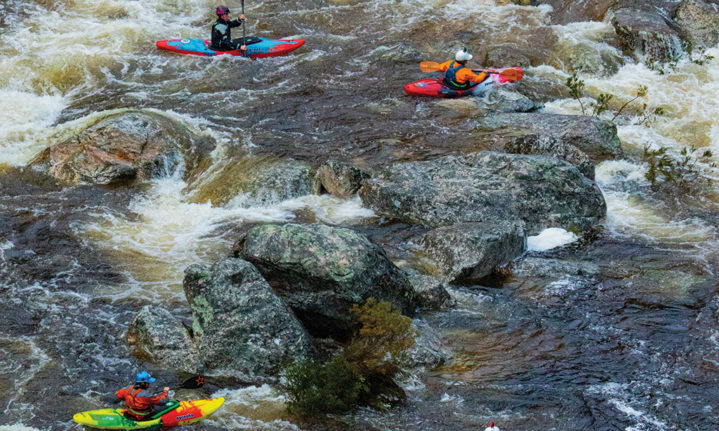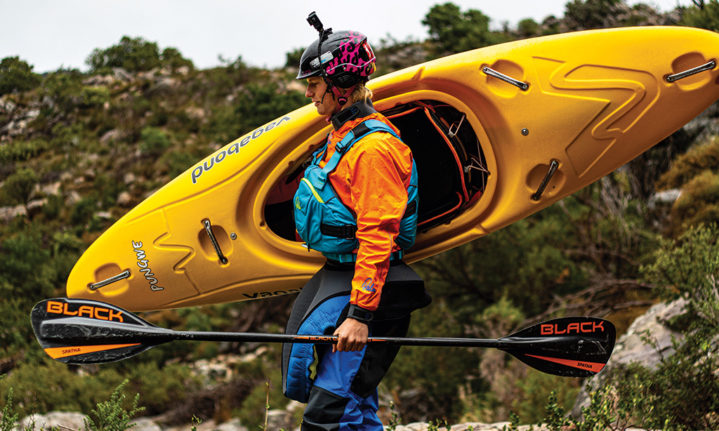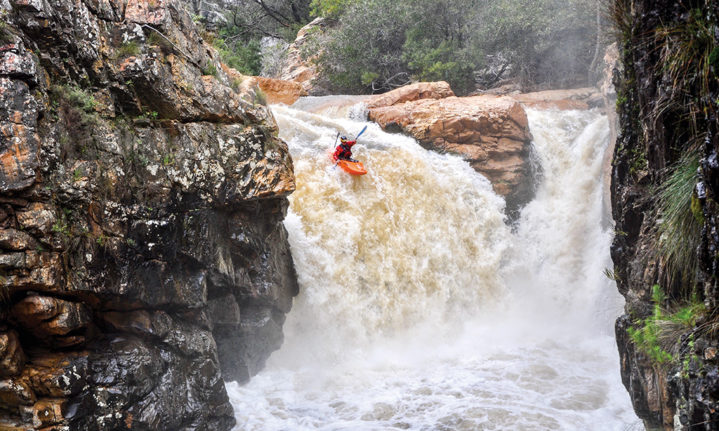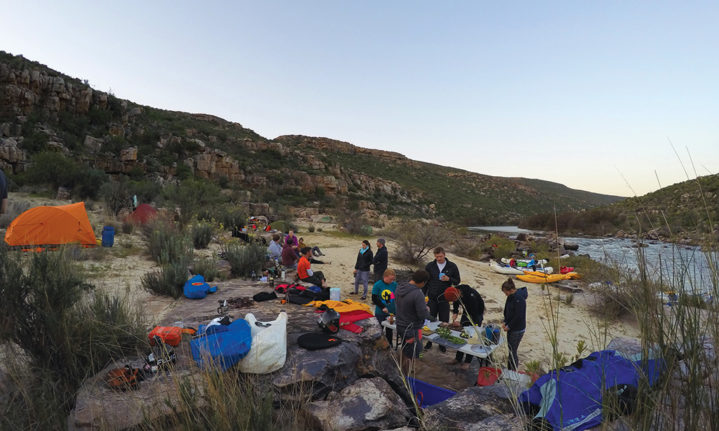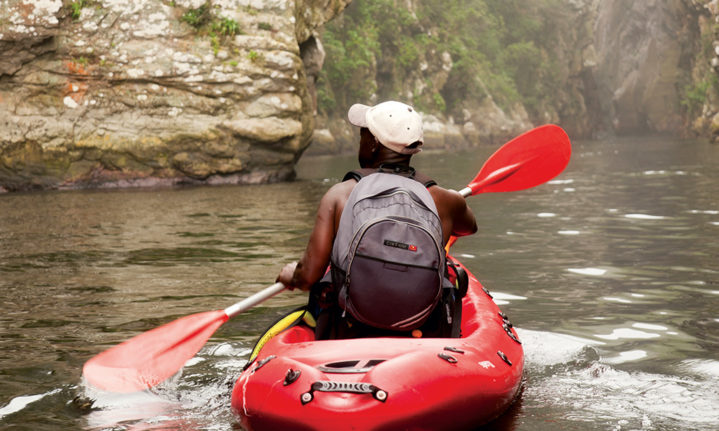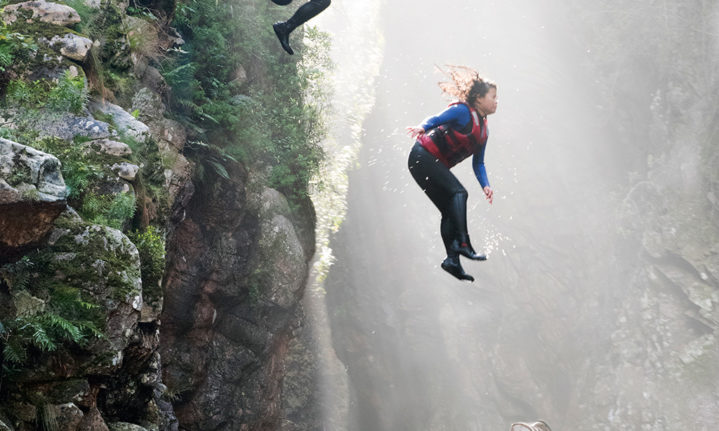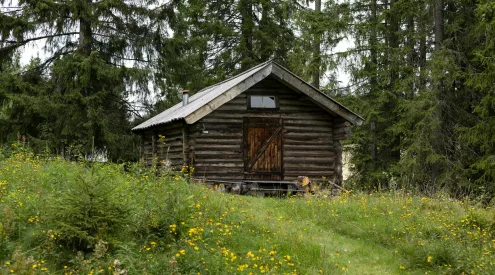Videos of kayakers dropping down 30-metre waterfalls grab our attention but there’s a lot more to expedition kayaking than being a daredevil. Matthew Sterne shines a light on some of the country’s pioneers.
Words: Matthew Sterne | Photography: Scott Erinders, Chad Fourie, Anton Crone, Dale Mor

Scott calls the White River, near Bain’s Kloof in the Western Cape, his ‘backyard run’ – 8km of the route can be paddled when conditions are right.
‘The principles are very similar to an over-night hike,’ expedition kayaker Scott Reinders says of the adventures he has in South Africa’s remote river gorges. ‘We go in a small team of ideally four to six people with an objective of getting from point A to point B, but with the added element of water. You have to be self-sufficient because there’s very little help coming in those way-out-there places we often explore.’
For the last 10 years, the frontier in local kayaking has been the hinterland of rural Eastern Cape, inland from Port St Johns. All of the big rivers there have been paddled, but there are whispers of a few stretches in the Umzimvubu’s upper tributaries that are yet to be claimed. ‘They’re often in the higher reaches of mountains. That’s where a lot of the exciting stuff still lies,’ Scott says.
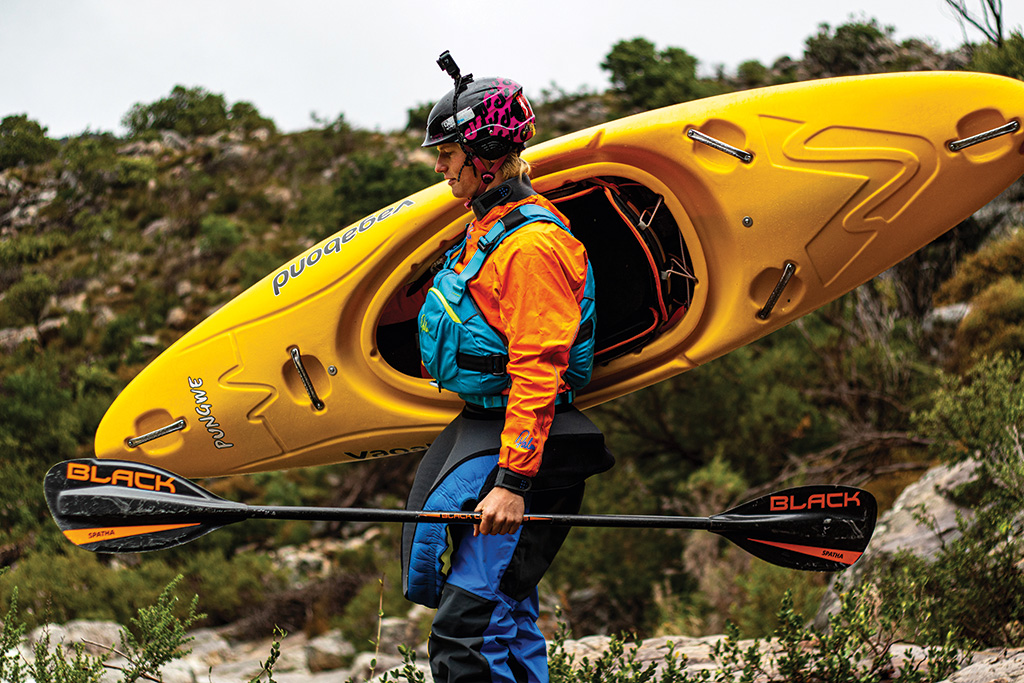
Scouting and picking lines is an important step before running a rapid – to choose a route that suits your ability.
Scott – who’s done first descents down three rivers and cut his teeth as a guide on the Zambezi (widely regarded as the best commercial white-water experience in the world) – says that the sense of remote exploration with a group of close mates is hard to beat. ‘You develop a great camaraderie on expeditions. And there’s a real magic to being on a river that’s so isolated.’
While the rapids and big waterfall drops are the major thrill on trips, it’s often the quieter aspects of expeditions that Scott enjoys most. ‘My favourite part is sitting around the fire sharing stories at the end of a really intense day. We’re often in a camp that no one has ever been to; leaving footprints where none have been before, and there’s something really special about that,’ he says. ‘I go to the Doring every year, not because of the rapids, but to be out there in the wild, sleeping under a blanket of stars.’

Rapids are ranked on a scale of difficulty and safety, with Class 6 being near impossibly dangerous to run. This is a Class 4 rapid.
Scott started canoeing in high school but was always drawn to the rapids more than the flat water. When a friend in computer class showed him photos of his brother, who was a pro kayaker, Scott knew what he wanted to do. ‘It was a natural step for me into the exploratory and thrilling side of paddling that is kayaking. It’s so satisfying to take a rapid well.’ The development of most kayakers from novice to expedition paddler follows a certain path. As soon as you’ve mastered what’s known as a ‘bomb-proof roll’, the faster you’ll progress in the sport. From there you’ll learn how to read white water, catch eddies and take safety classes to learn swift water rescue. From that point on, the untamed white water beckons.
South Africa has a history of producing world-class kayakers. Tim Biggs was the first man to kayak the three main tributaries of the Amazon. For a long time, the world’s best all-round kayaker was Steve Fisher, who did the first descent of the Grand Inga rapids of the Congo River, which boasts a section of the world’s biggest and most dangerous white water. Hendri Coetzee was among the greatest expedition paddlers of this generation. He kayaked the Nile from source to sea, twice, and was the first to run the Nile’s Murchison Falls section, a feat he repeated eight times in all. Sadly, he paid the ultimate price though, when he was dramatically taken by a crocodile, mid-stroke, on a tributary of the Congo River.
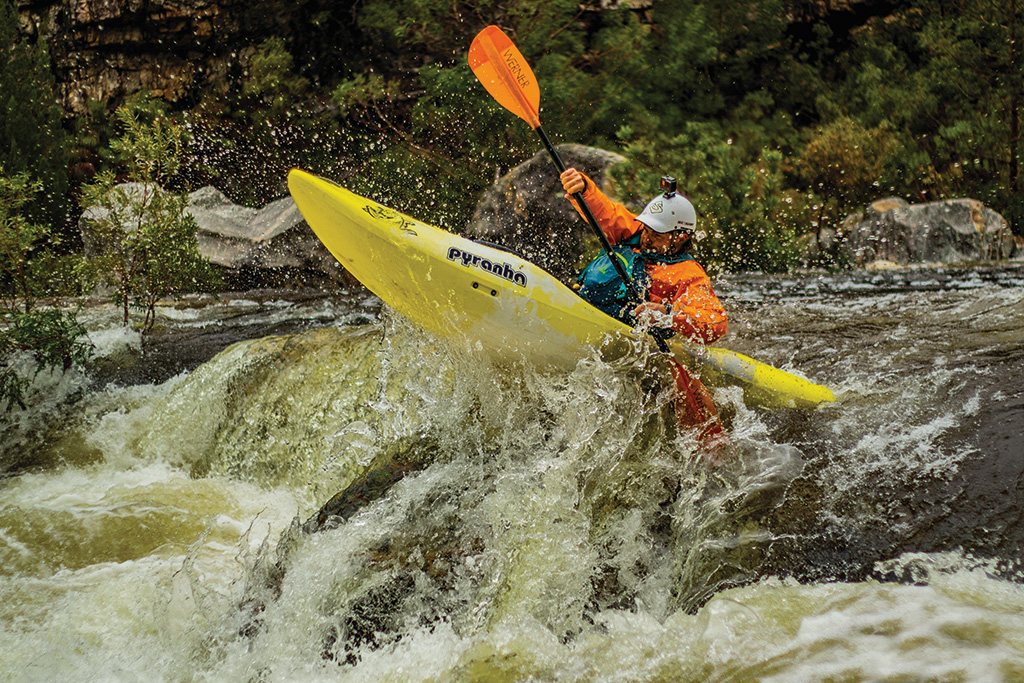
Demonstrating a perfect ‘boof stroke’, a manoeuvre used to propel a kayak over a rock or waterfall lip.
The Kunene River, between Namibia and Angola, holds an especially revered place in the minds of Africa’s expedition kayakers. It’s a wickedly wild river where the big rapids, narrow gullies, inhospitable terrain and monster crocodiles are the stuff of legend. Respected kayaker and owner of Vagabond Kayaks, Celliers Kruger, says, ‘parts of the Kunene are without doubt one of the most dangerous sections in the whole of Southern Africa’. It was pioneered by Willem van Riet, considered the grandfather of river exploration in southern Africa, in the sixties.
But Scott is eager to point out that not all kayaking is serious Class 5 stuff. ‘It’s like surfing,’ he says. ‘People start at Muizenberg and can work their way up to Dungeons if they want to. That same spectrum exists with kayaking. You get big river trips but you can also get Class 1 and 2 expeditions, which are more accessible.’ Either way, it’s about enjoying time outdoors, letting your day-to-day worries float away and soaking up some of the country’s most beautiful landscapes.

Join a club
The Cape White Water Club often arranges trips on the Palmiet and Doring Rivers for experienced kayakers, find them on Facebook. White Water Republic is a support system for kayakers within Gauteng, Northwest and the Free State – also on Facebook.
White-water thrills you too can do
If you’re not a pro or Red Bull charger, Southern Africa still offers some pretty insane commercial white-water trips
Western cape
Doring River, Cederberg
The downside of this one is it happens in winter, and sometimes those mischievous rapids are pure snowmelt. With winter rains, the Doring becomes an energetic torrent cascading through a mini-canyon in the northern Cederberg. Part of the attraction is the remote location and wilderness scenery of rugged koppies and ancient mountains. Classified as a Grade 3-4 river, its volatile water is interspersed with flat sections so it’s a good place to cut your teeth on white-water adventuring. Operators generally use two-person Croc rafts, which means you’re in control of your own navigation – sometimes to the detriment of your fellow rafters. Just three hours drive from Cape Town, it’s an easy weekender trip of two days on the water and a night camping under the stars on the river bank. The season runs from mid-June to September. From R2 500 pp | 021 683 3698 gravity.co.za

KwaZulu-Natal
Tugela, Drakensberg
KZN’s longest river, The Tugela, starts as a placid bubbling brook high up in the Berg, gathering momentum and might as it surges towards the Indian Ocean, bloated by summer thunderstorms. There’s no time for leisurely drifting as you encounter the boils and standing waves of Rocky Horror, Off the Wall and Frog’s Playground, before being ‘liquidised’ and thoroughly cleansed in the Washing Machine. Itchyfeet SA offers both half-day (R650pp) and multi-day white-water trips (from R2 500 pp for one night/R3 500 for two nights) in rafts or white-water kayaks. You’ll be bobbing down 130-odd kilometres of wild and rugged country along the Tugela from Bergville to downstream of Weenen. White-water season is in summer from October to March. 083 236 9010 | itchyfeetsa.co.za
Zimbabwe/Zambia
Zambezi River
To the backdrop of Vic Falls and under the bridge that spans the narrow Batoka Gorge separating Zimbabwe from Zambia, you’ll plummet headlong down the Toilet Bowl on an eight-person raft, before being gobbled up by the Muncher. Then, dunked and bedraggled, you’ll face the Three Ugly Sisters, followed by their Mother. Funny thing is, people travel from around the world to do just that. The Zambezi’s Batoka Gorge is classified as a Grade 5 river so, to quote the British Canoe Union, it’s ‘extremely difficult – long and very violent rapids with severe hazards, continuous, powerful, confused water, steep gradients…’ you get the picture. Recommended operator, Safpar, based in Livingstone, is offering specials for a full day rafting plus a sunset river cruise. From R2 700 pp | +260 968 32060 safpar.com
From the Vic Falls (Zim) side, contact shearwatervictoriafalls.com | wildhorizons.co.za.

Looking for a slightly more sedate thrill?
The majestic Storms River Gorge may be exactly what you need. Check out these local operators:
Untouched Adventures. With Untouched Adventures, you can experience Storms River all year round. On days when the sea is calm, you’ll paddle from the harbour across the river mouth and pass underneath the famous Storms River Suspension Bridge. As you progress further upriver, the towering walls of the breathtaking gorge envelope you.
When the sea is a bit uppity, you’ll get to walk a little way through the Tsitsikamma Forest. Your guide will take you across the suspension bridge, so that you can kayak from higher up the river.
When the river becomes too shallow to paddle, you’ll swap out the double, sit-on-top kayaks for a lilo and paddle deeper into the gorge. Don’t despair if this section of the route feels too tranquil – there’s a bit of potential cliff jumping on your way back! From 695 pp | 073 130 0689 untouchedadventures.com
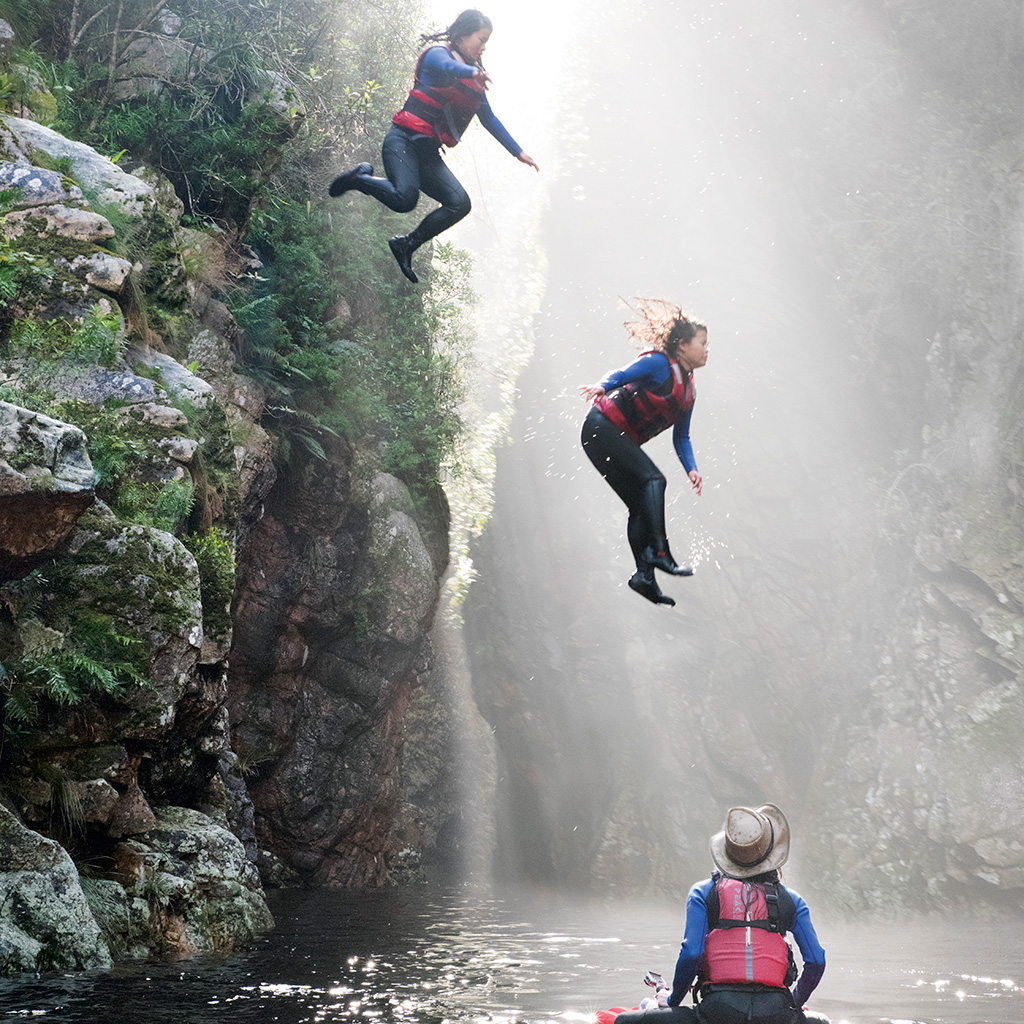
Dirty Boots
The company’s kloofing options are divided into a family-friendly Green Route and a Red Route, both of which include tube jumps, swim- ming and rock jumps.
Along the Green Route, you’ll start your adventure with a short upstream paddle to the beach. With your tube on your back, you’ll walk a further 200m to the next pool. At the Old Storms river pass, you’ll paddle for about 800m on a Stand Up paddle board where, if you are feeling particularly adventurous, you get to cliff jump from eight metres up. The route takes around three hours to complete.
The Red Route is for those who are relatively fit and it takes about five hours, starting with an 800m walk down the side of the gorge. On this route, you’ll spend your time flatwater paddling, bouldering and cliff jumping.
From 650 pp | 079 636 8008 www.dirtyboots.co.za









